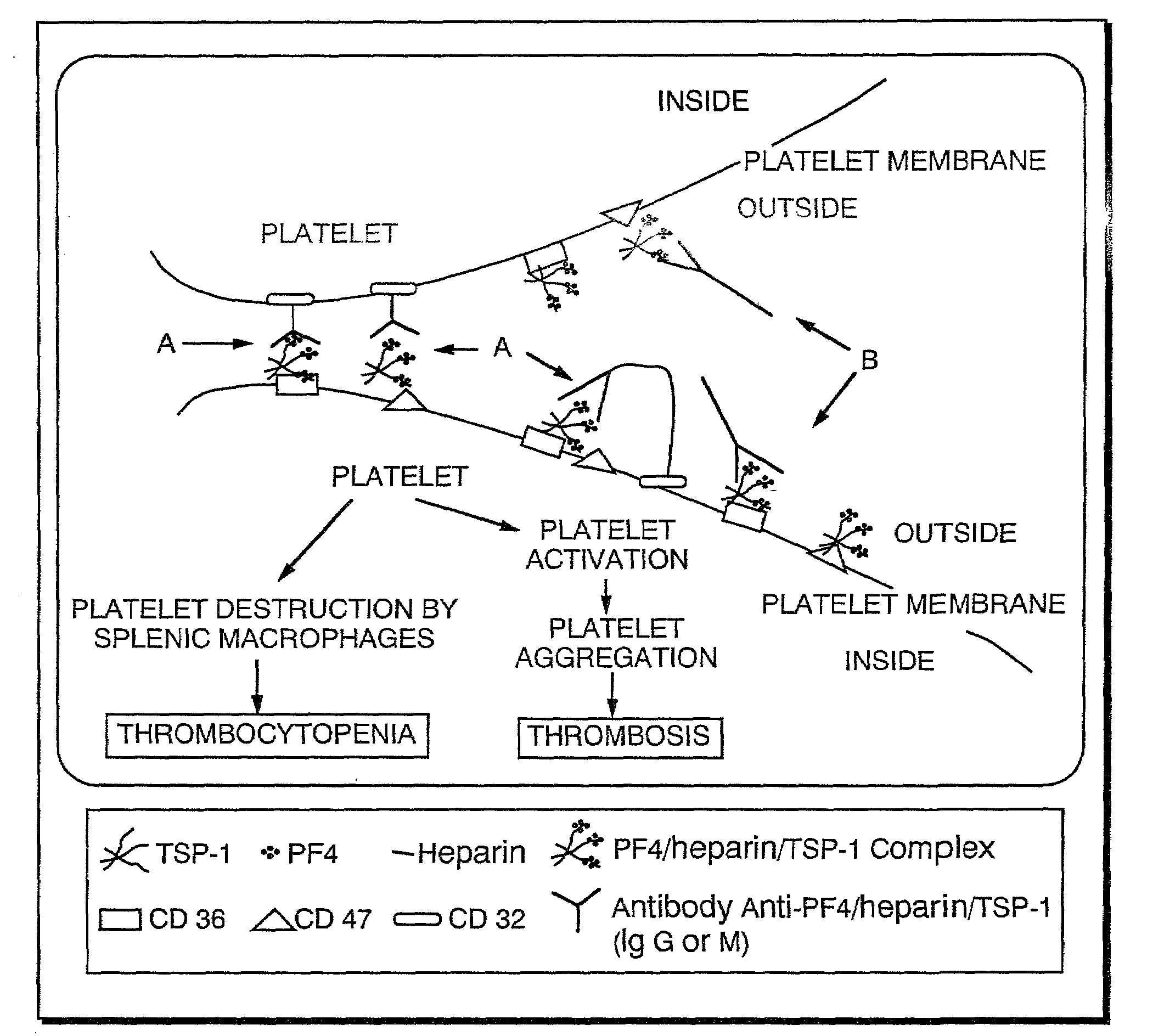Diagnostic assay for type 2 heparin-induced thrombocytopenia
a thrombocytopenia and assay technology, applied in the field of diagnostic assays for type 2 heparin-induced thrombocytopenia, can solve the problems of heparin-induced thrombocytopenia, difficulty in diagnosing hit, and associated side effects of therapeutic use of heparin, so as to increase the risk of thrombocytopenia
- Summary
- Abstract
- Description
- Claims
- Application Information
AI Technical Summary
Benefits of technology
Problems solved by technology
Method used
Image
Examples
example 1
Isolation of PF4 and TSP-1.
[0065]The starting material for the purification of human PF4 and TSP-1, both of which are abundant platelet α-granules heparin-binding proteins, was outdated platelet concentrates obtained from the Brigham and Women's Hospital Blood Bank (Boston, Mass.). PF4 has a high affinity for heparin, and requires 1.5 M NaCl before it can be eluted from heparin-Sepharose column (FIG. 1A). In contrast, TSP-1 requires only 0.55 M NaCl for elution from a heparin-Sepharose (FIG. 1A). The platelets were washed, and the supernatant from thrombin-treated platelets was prepared as described previously (Lawler, J., et al., J. Biol. Chem., 260:3762–3772 (1985); Levine, S. P., et al., J. Biol. Chem., 251:324–328 (1985)) with some modifications according to the following protocols:
TSP-1 Isolation:
[0066]The supernatant was applied to a column of heparin-Sepharose CL-6B (Pharmacia) at 4° C. Stepwise elution was carried out with 15 mM Tris-HCl (pH 7.6) and 2 mM CaCl2 containing 0....
example 2
Demonstration of Heparin, TSP-1 and PF4 Complex Formation: Iodination of Heparin and Gel Permeation Chromatography.
[0069]In order to determine if PF4, TSP-1 and heparin can interact (e.g., complex) with each other in solution, mixtures comprising 125I-heparin (4.8×105 cpm / 0.17 U˜4.8×105 cpm / μg), potentially complexed as PF4 / 125I-heparin, TSP-1 / 125I-heparin or PF4 125I-heparin / TSP-1 were applied to Sephadex G200 (Vo=16 ml, Vt=80 ml) in Tris-buffered saline with 2 mM CaCl2. Elution of 125I-heparin containing complexes was monitored using a gamma counter. In order to preform heparin binding protein / 125I-heparin complexes, 2.5 μl of 125I-heparin was incubated with either 0.5 ml of 40 μg / ml PF4, or with 0.5 ml of 10 μg / ml TSP-1 or with 0.5 ml of 40 μg / ml PF4 and 10 μg / ml TSP-1. Preformed heparin binding protein / 125I-heparin complexes were incubated 30 min at 4° C. and applied to the column. Heparin was derivatized and iodinated as described previously (San Antonio, J. D., et al., Biochem...
example 3
Optimizing the Ratio of Heparin and Heparin Binding Proteins to Produce Complexes Suitable for the Detection of Antibodies Indicative of HIT.
[0071]Binding of HIT antibodies to complexes between heparin and PF4, heparin and TSP-1 or a mixture of heparin, PF4 and TSP-1, was determined by ELISA. Plasma samples from 6 HIT patients were analyzed. PF4 / heparin, TSP-1 / heparin or PF4 / heparin / TSP-1 complexes were preformed by incubating PF4 (1.25 to 40 μg / ml), or TSP-1 (1.25 to 40 μg / ml) or a mixture of PF4 (1.25 to 40 μg / ml) and TSP-1 (1.25 to 40 μg / ml) with heparin (0 to 1 U / ml) in PBS for 30 min at +4° C. The optimal ratios of PF4 / heparin, TSP-1 / heparin and PF4 / heparin / TSP-1 required to produce complexes capable of binding heparin-induced antibodies were determined in preliminary studies. The optimum concentrations used for PF4 / heparin ELISA: 20 μg / ml PF4 and 0.03 U / ml heparin; for TSP-1 / heparin ELISA: TSP-1 1–5 μg / ml TSP-1 and 0.03 U / ml heparin; and for PF4 / heparin / TSP-1 ELISA: 20 μg / ml P...
PUM
| Property | Measurement | Unit |
|---|---|---|
| concentration | aaaaa | aaaaa |
| concentration | aaaaa | aaaaa |
| molecular weight | aaaaa | aaaaa |
Abstract
Description
Claims
Application Information
 Login to View More
Login to View More - R&D Engineer
- R&D Manager
- IP Professional
- Industry Leading Data Capabilities
- Powerful AI technology
- Patent DNA Extraction
Browse by: Latest US Patents, China's latest patents, Technical Efficacy Thesaurus, Application Domain, Technology Topic, Popular Technical Reports.
© 2024 PatSnap. All rights reserved.Legal|Privacy policy|Modern Slavery Act Transparency Statement|Sitemap|About US| Contact US: help@patsnap.com










